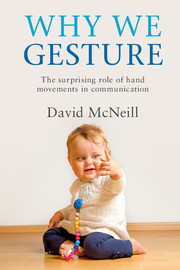Book contents
- Frontmatter
- Dedication
- Contents
- List of figures
- List of tables
- Preface
- Acknowledgments
- Part I Gesture-orchestrated speech
- 1 Why we gesture
- 2 The growth point
- 3 New forms of human action
- 4 Orchestration and unpacking
- 5 Mimicry and metaphor
- Part II Phylogenesis, ontogenesis, brain
- Part III The last page
- References
- Index
4 - Orchestration and unpacking
from Part I - Gesture-orchestrated speech
Published online by Cambridge University Press: 05 December 2015
- Frontmatter
- Dedication
- Contents
- List of figures
- List of tables
- Preface
- Acknowledgments
- Part I Gesture-orchestrated speech
- 1 Why we gesture
- 2 The growth point
- 3 New forms of human action
- 4 Orchestration and unpacking
- 5 Mimicry and metaphor
- Part II Phylogenesis, ontogenesis, brain
- Part III The last page
- References
- Index
Summary
This chapter explains the concept of gesture-orchestrated speech in full. Our arguments so far have been that gesture–speech unity embodies the core meaning of a sentence, a meaning that takes the form of “one meaning is two things,” and occupies both simultaneous and successive awareness. The core meaning, cast in different semiotic modes at the same time—a dual semiosis and an imagery–language dialectic—is unstable and seeks stability through unpacking. Unpacking parcels the growth point (GP) and its context into a construction (or approximately one).The more discontinuous an utterance from the context, the greater its communicative dynamism (“communicative dynamism” is the extent to which a given spoken or gestured form “pushes the communication forward,” Firbas 1971), and the more probable a gesture, the more internally complex it will be, and the more complex the synchronous co-expressive speech as well (see Figure 1.3). The GP and its unpacking “absorbs” the immediate context, and this also shapes gesture-orchestrated speech. In narrative discourse, the communicative dynamism push comes with a sense of “ongoingness.” All of this can go into one gesture–speech unit, and is the packaging of gesture-orchestrated speech.
Orchestration and unpacking
Orchestration is the action of the vocal tract organized around manual gestures. A surface reflection of orchestration is the amount of time speakers take to utter sentences. This is remarkably constant, between one and two seconds regardless of the number of embedded sentences (up to five or six, from 1970s notes). One to two seconds is also the duration of a gesture typically, and the constancy is explained if gestures orchestrated them. Second, when a listener indicates he does not understand, the speaker's gestures tend to increase in frequency but not change in form, suggesting increased effort with more gesture–speech units while the gesture-orchestrated speech within each unit stays the same (Hoetjes et al. 2015). Having more gesture–speech units, the overall speech rate slows (each new gesture–speech unit adding another one or two seconds), and this Hoetjes et al. also found—2.1 down to 1.7 words per second over repetitions. Third, languages differ in prosodic/rhythmic patterning and flows of words, and fluent bilinguals tell me they experience changes of muscular organization of the vocal tract when switching languages (for example, from English to French).
- Type
- Chapter
- Information
- Why We GestureThe Surprising Role of Hand Movements in Communication, pp. 54 - 85Publisher: Cambridge University PressPrint publication year: 2015



